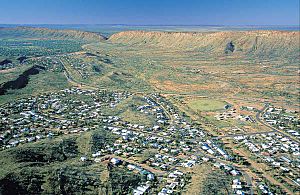Solar Cities in Australia facts for kids

Solar Cities was a special program in Australia. It cost about A$97 million. The goal was to show how we can use solar power and save energy in cities. It also looked at new ways to charge for electricity. This was all to create a sustainable energy future.
The first five Solar Cities were Adelaide, Alice Springs, Blacktown, Central Victoria, and Townsville. Later, the government added Coburg and Perth. The program wanted to show how technology, changing habits, and new energy prices could help Australia have a greener energy future.
Contents
Why Solar Cities Mattered
The main goals of the Solar Cities program were to show what's possible with:
- Solar power (using the sun for electricity).
- Smart meters (devices that track energy use in detail).
- Energy conservation (saving energy).
- New ways to price electricity.
- Living in a more sustainable way in cities.
It was a team effort involving governments, private companies, and local communities. People could get special loans to buy solar panels for their homes. The project also helped families with lower incomes save money on energy.
The program aimed for several things:
- Help people understand their energy use better.
- Show electricity companies how much money they could save.
- Test new green energy ideas safely.
- Help governments create future energy and climate change policies.
The big idea was to work together to protect our environment and natural resources. The program always said that saving energy first was the most important step. After that, using renewable energy sources like solar was key.
Solar City Projects Across Australia
Many cities across Australia joined the Solar Cities program. Each city tried different ways to use solar power and save energy.
Adelaide's Solar Plan
Parts of Adelaide, like Salisbury, Tea Tree Gully, Playford, and Adelaide City Council, were part of this project. Adelaide often had problems with electricity supply during busy times. It also had higher electricity prices and lots of sunshine.
Here are some things Adelaide tried:
- About 1,700 solar panels were put on homes and businesses. This doubled South Australia's solar power.
- People got help to pay for their solar systems.
- Solar panels were installed on famous buildings, like the Adelaide Central Markets.
- 7,000 smart meters were put in homes and businesses. These helped people see how much energy they were using.
- 40,000 energy-saving kits were given out.
- A big campaign encouraged people to choose green power.
- Some community homes tested solar power and solar hot water systems.
Alice Springs' Green Efforts
Alice Springs also had exciting plans:
- Several large solar power systems were built.
- 400 smart meters were installed in homes and businesses. These meters, combined with special pricing, encouraged people to use less energy during busy times.
- Solar panels on homes and businesses provided clean energy for the town.
- People who produced extra solar energy could sell it back to the power grid. This encouraged more people to get solar panels.
- 1,000 solar hot water systems were installed in homes.
- 850 energy audits were done. Experts visited homes to help people manage their energy. This was expected to cut energy bills by up to 20%.
In 2008, a big project started to build Australia's largest rooftop solar system. It was placed on the Alice Crowne Plaza hotel. By early 2009, over 600 homes and 30 businesses had joined Alice Solar City. Many energy surveys were done, and money was given out for energy-saving ideas. The solar systems installed were expected to save 400,000 kWh of energy each year. This is like the energy used by about 50 homes in Alice Springs.
The project aimed for big environmental benefits:
- Less energy needed: 5,352 kW.
- Less energy used each year: 10,667 MWh of electricity and 5,233 GJ of gas.
- Less CO2 pollution: 8,683 tonnes from electricity and 4,259 tonnes from gas each year.
- This was like taking 3,266 cars off the road every year. It was about 22% of all cars in Alice Springs!
Blacktown's Energy Solutions
The company BP Solar led the project in Blacktown. This project included:
- Energy efficiency checks.
- 3,500 energy-saving advice sessions.
- Installation of solar water heaters.
- Solar panels that produced one megawatt of solar energy.
Central Victoria's Solar Parks
The Central Victoria Solar City project started in 2008. It covered a large area with 14 local councils. People in Ballarat and Bendigo could support solar power even without panels on their own roofs. This was because two large solar parks, each making 300 kW of power, were built nearby.
Coburg's Focus on Families
The Coburg Solar City project began in 2008. A main goal of this program was to help families with lower incomes save energy and use solar power.
Perth's Stage One Plans
In the first stage of the Perth Solar City project, these things were planned:
- Install 6,000 smart meters and 2,514 smart meters with monitors.
- Give out and install 6,300 energy-saving kits.
- Have 20 schools install a 1 kW solar system and monitors for classrooms.
- Install 663 1 kW solar panel systems and 695 solar hot water systems.
Townsville's Project
Ergon Energy led the project in Townsville from 2007 to 2013. This project offered:
- Free energy checks for homes.
- Installation of smart meters.
- Solar panels put on selected homes and public buildings.
See also
 In Spanish: Ciudades solares en Australia para niños
In Spanish: Ciudades solares en Australia para niños

